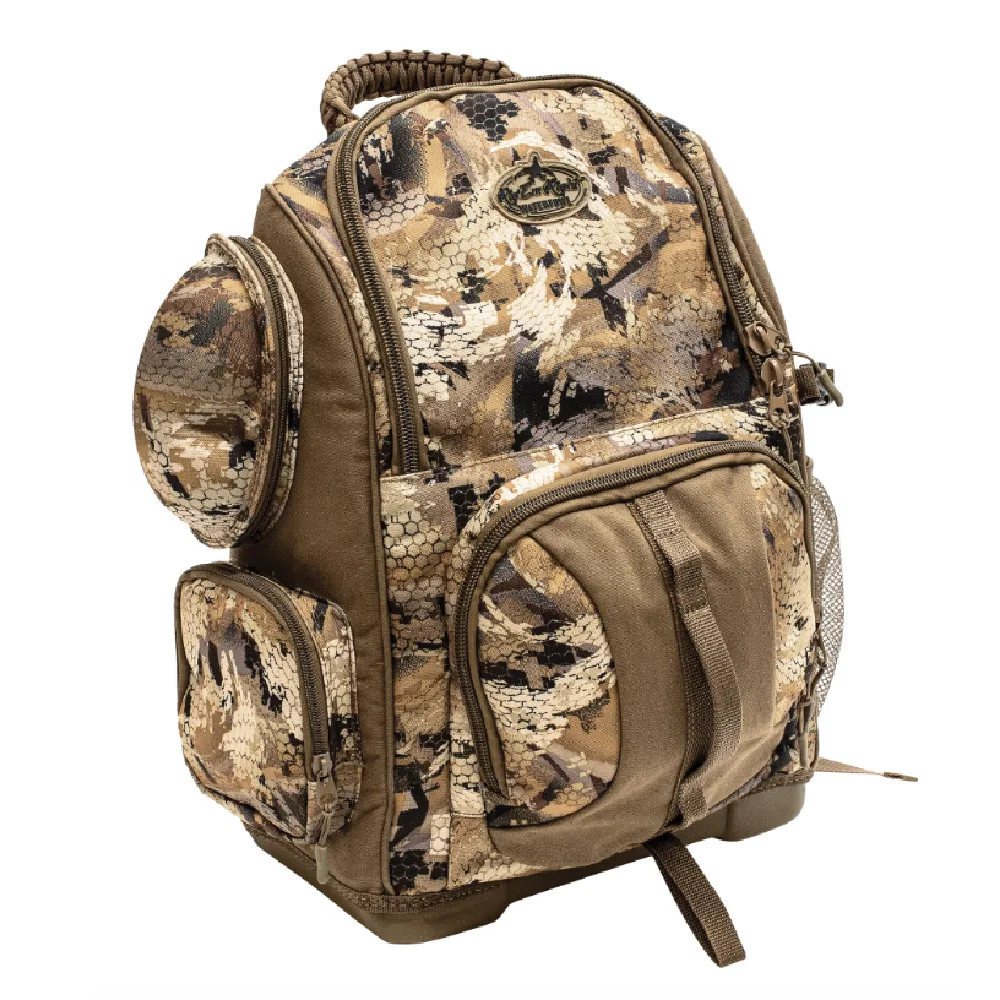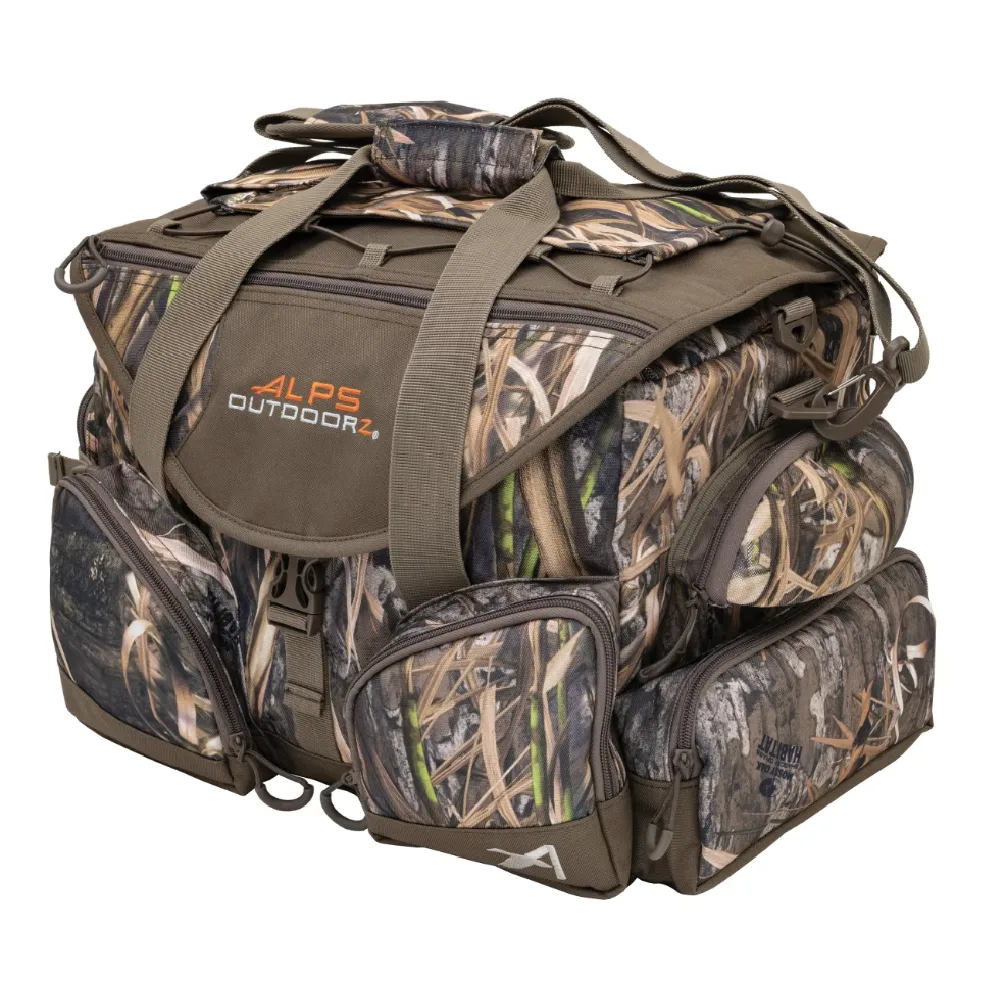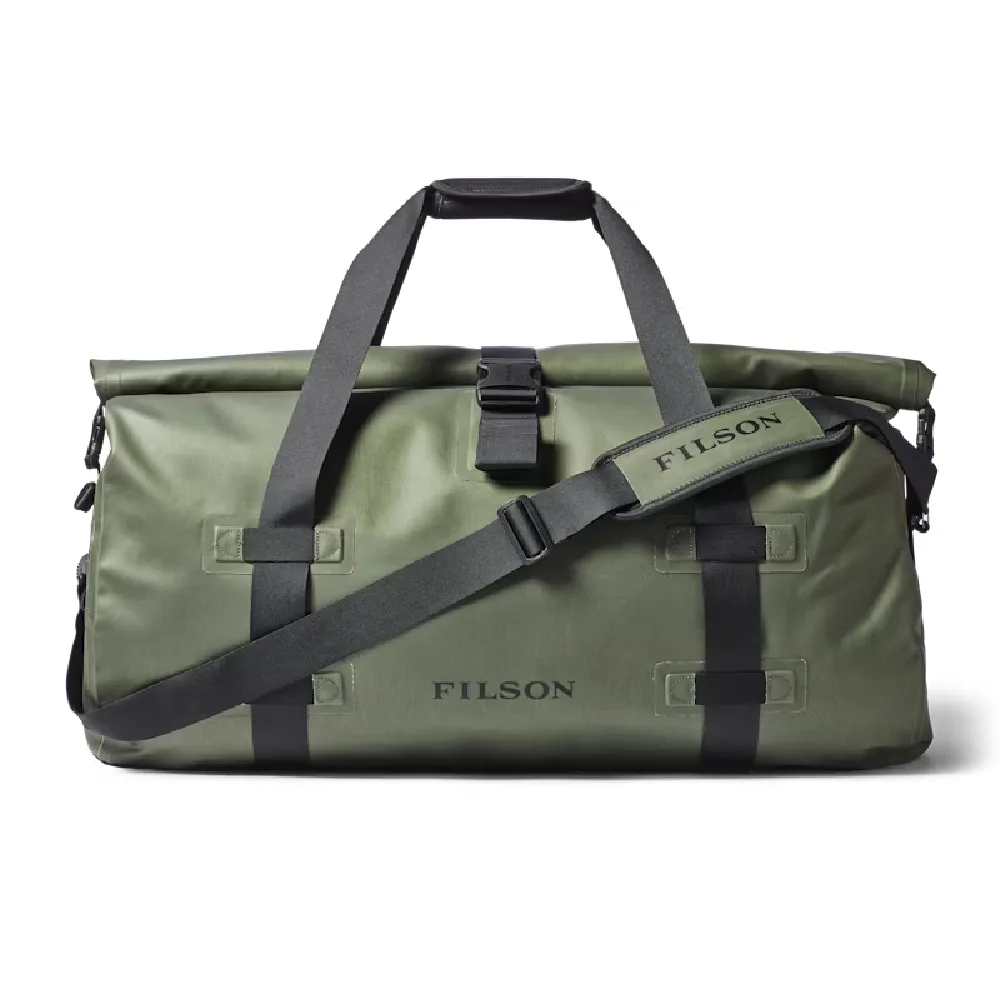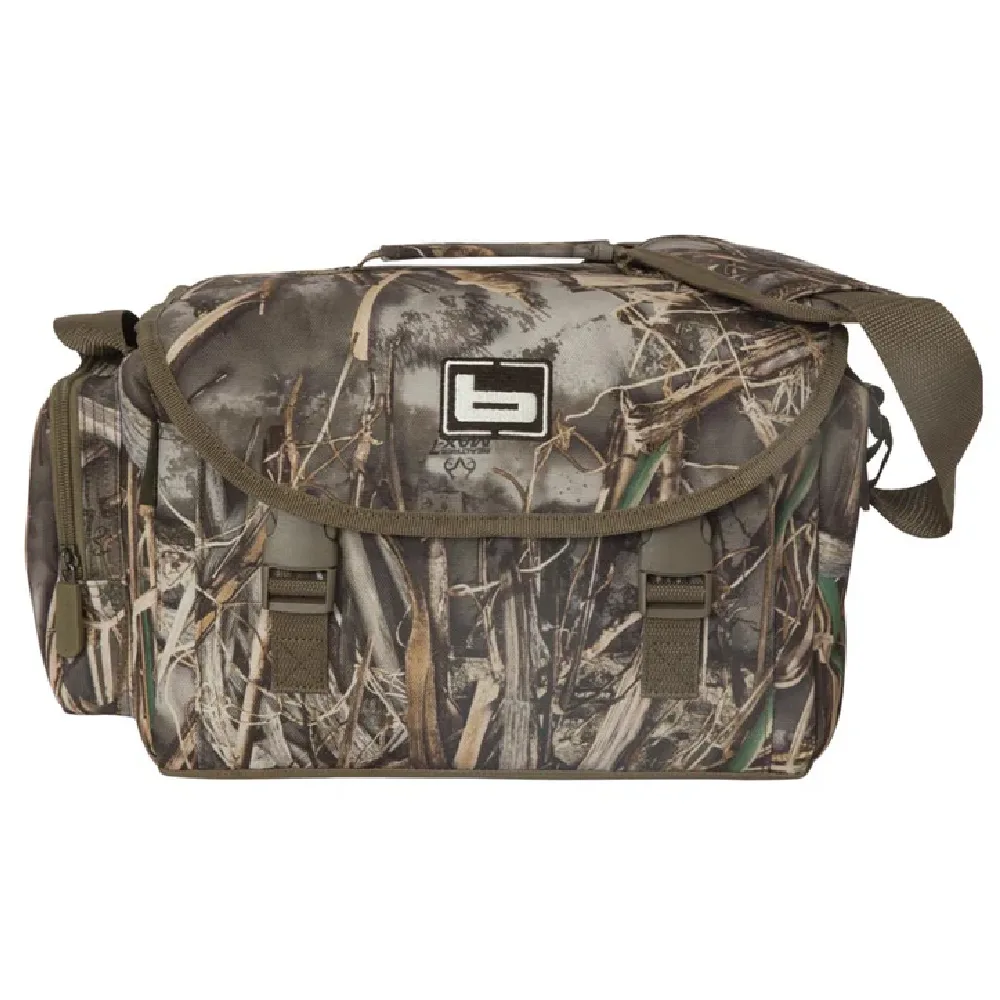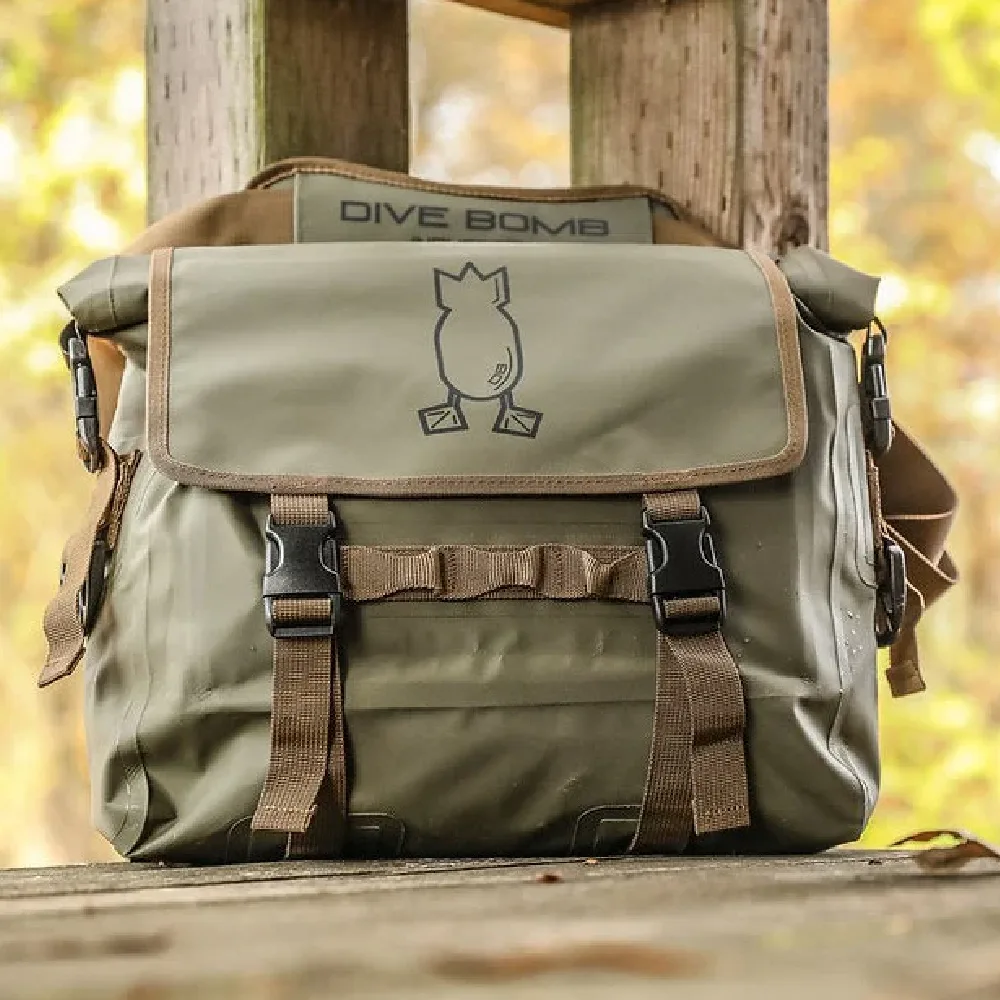We may earn revenue from the products available on this page and participate in affiliate programs. Learn more
When I started waterfowling in 1974—and back then, it was simply known by the all-inclusive term “duck hunting”—we didn’t have blind bags, the modern day equivalent of carry-on luggage for duck and goose hunters. What we had were pockets. Lots and lots of pockets. And we filled those pockets to overflowing with what we needed, which, to a 10-year-old, was 4.73 metric tons of 20-gauge ammunition.
My old man packed a pseudo blind bag. It was, if memory serves, an olive-drab heavy canvas military style shoulder bag—something, I believe, he brought back with him from Vietnam in ’66. Inside was a spare pack of Camel Lights, a Hershey chocolate bar (with almonds), a bottle of 7UP soda, and some toilet paper wadded up in a sandwich bag. He may have had a few 2-3/4-inch No. 5 shells for his Remington 1100, but those he usually carried in his old-school Montgomery Ward shell vest.
While I resisted the idea of carrying a blind bag afield for quite a few years, I’ve since seen the proverbial light. Like hunting backpacks, they serve me well during the season and are also a place to store all my gear during those not-so-nice off-season months. When it comes to blind bags, today’s choices are many; the designs and layouts, the bells ‘n whistles, even more so. Here’s an in-depth look at what makes the best blind bags, well, the best.
Best Overall: Rig ‘Em Right Lowdown Floating Backpack
Best Waterproof: Filson Sportsman Dry Duffle Bag
Best Budget: Banded Air II Blind Bag
Most Verastile: Alps Outdoorz Floating Deluxe Blind Bag
Best Sling: Sitka Sling Choke
Best Roll-Top: Dive Bomb Dry Blind Bag
Best Overall: Rig ‘Em Right Lowdown Floating Backpack
Specs
Dedicated thermos holder (a crucial feature, in my opinion)
Full foam flotation
Molded water-resistant bottom
Built-in sunglasses case
Interior clear zippered pockets
HUGE #550 paracord handle
Front and right-side handles
Pros
Incredible amount of storage space
Year-round multi-species/multi-purpose use
Solidly built
Multiple handles for convenience
Good strong zippers
Compartmentalized
Makes for a great travel bag
Cons
I looked hard; couldn’t find any
Matthew and Heather Cagle at Rig ‘Em Right make damn good stuff. Period. One of the nicest things about their gear is it’s incredibly well thought-out; made BY duck and goose hunters FOR duck and goose hunters. The stuff just flat works.
The Rig ‘Em Right Lowdown Backpack is a case in point. It has roughly 1,180 cubic inches of storage inside, plus front and side pockets and a mesh/elastic pouch with a lock strap to the right (a.k.a., a thermos holder for me). It’s plenty big enough, but not so big you’ll be tempted to pack it with tons of unnecessary gear. I’m not a fan of dedicated sunglass cases on blind bags; but you can put something else you don’t want busted up in there, like Pop-Tarts or hard-boiled eggs.
I am, though, a big fan of multiple handles, and the Lowdown has them, meaning you can pick it up securely and easily regardless of how it’s laying. Zippered pockets, safe-storage interior pockets, a beefy paracord top handle, a padded-foam back, a water-resistant bottom, good stitching—and it’s good-looking enough to be used as a travel/computer bag. It even has a laptop pocket for that purpose. Well done, Rig ‘Em Right.
Best Waterproof: Filson Sportsman Dry Duffle Bag
Specs
900-denier polyester build
Heavy-duty waterproof zipper top with quick-clip buckle
D-rings
Removable padded fully adjustable shoulder strap
Top flap locks down via dual buckle/snap system
Roughly 915-cubic-inch capacity
Welded seams
Pros
Built incredibly tough
Undeniably keeps gear dry (if used as instructed)
Handy T-handle zipper pull
DIY interior divider system
Clear zippered pocket inside top lid
Fantastic camera/video bag
Cons
Expensive
You’re looking at a blind bag that’s going to run you well north of $300. Is the stuff you’re putting inside worth that much protection? Maybe; maybe not. That’s up to you. That said, the Filson Sportsman is an absolute tank of a blind bag. Think the Fort Knox of Blind Bags, and you’re getting close. There’s plenty of interior room, and while the dividers are a nice touch (especially for packing photography/videography equipment), I’d yank them out and stuff the inside full of gear I didn’t want to get wet.
Inside, you’ll find a zipper pocket at one end and a pouch at the other, plus a tube of zipper lubricant, along with instructions on how to use it. Nice touch, Filson. The D-rings on the lid are also well done, as is the heavy-duty padded shoulder strap—a departure from the cheap nylon bite-into-your-flesh straps found on 99 percent of today’s bags. The quick-clips are big and easy to undo while wearing gloves. The T-pull interior zipper makes it easy to open and close. Sure it's spendy, but the Sportsman Dry Bag might just be the definitive all-season bag.
Best Budget: Banded Air II Blind Bag
Specs
900-denier fabric
Adjustable padded shoulder strap
Zippered side pouch
Closed-cell foam flotation
“Armored” bottom
Zip-lid covered interior
Pros
Great for walk-in hunters
Plenty of interior storage, unless you plan on bringing furniture
Good-looking bag; reasonably tough and rugged
Cons
Hook ‘n loop secondary lid closure can fill with debris, rendering it useless
Relatively small, if you’re looking to pack a ton of gear
Questionable zipper quality on side pouch
I’ve used an earlier generation of what looks like Banded’s Air II bag for many years now. It started showing its age several seasons ago, but it still works just fine. Hopefully, this latest version is as long-lasting.
Banded makes a huge range of outdoor gear, among it a variety of blind bags. With a cost that’s less than $30 for the Max5 pattern, the Air II is one of their least expensive models—and unless you want to haul a water buffalo with it, it’s more than adequate. A bare-bones interior, front pouch, zippered side, zip-top lid, and a handful of camouflage options make this bag definitely worth consideration. No, it’s not the Rolls Royce of blind bags, and it has a couple of downsides, such as the hook-and-loop secondary lid closure filling with junk and becoming almost immediately ineffective. But all in all, and especially for new hunters looking to cut costs a bit, the Air II is a great choice for a bag.
Most Versatile: Alps Outdoorz Floating Deluxe Blind Bag
Specs
Pop-Top zippered lid
Four zippered interior pockets, plus end pouches
Optional hook ‘n loop inside divider included
Two large “stay open” front pouches with grommeted drains
Exterior end pouches
Molded waterproof bottom
Large exterior full-length rear pouch with strap closures
16 elastic shotshell loops inside
Two interior dog-style clips
Pros
Rear pouch can hold a full-size thermos
Shotshell loops keep various shot sizes handy
Large interior
Adjustable padded shoulder strap
Useful for other purposes
Top opens wide allowing easy access to gear inside
Cons
Full-length rear pouch has no drain holes
End pouches are a bit snug
If I’m going to pay more than $50 for a blind bag—which isn’t a terrible price for a bag of this quality—I’d like to be able use it for more than 107 days. Enter the Floating Deluxe Blind Bag from Alps Outdoorz. Duck season ends, and you just swap those calls and gloves and boxes of shotshells for a selection of hand tools, tape measure, hammer drill, safety glasses, and work gloves, and you’re good to go for the remaining 258 days on the calendar.
The only thing I don’t care for with the Alps Outdoorz blind bag is the corner-to-corner style shoulder strap; I always find they’re in the way, regardless of how long they are. The ‘Open Wide’ zippered top is great for access, and there’s a goodly amount of room inside. I would have made one or two of the interior pockets waterproof instead of mesh for stay-dry gear, but a plastic bag will solve that. I applaud the person responsible for designing the front pouches with grommeted drains, but drains in the rear would be helpful as well. The waterproof molded bottom is rock-solid, and comes up a full 2 inches on the sides, providing ample protection. Overall, it’s a very nice multi-purpose bag.
Best Sling: Sitka Sling Choke
Specs
Innovative sling design
Integrated duck strap
Water repellent finish
Beverage sleeve
Front quick-clip cinch strap
Comfortable back padding
Pros
Comfortable and fully adjustable
Doesn’t interfere with shouldering a shotgun/shooting
Circular zipper pulls work well with gloves
Padded top and side carry handles
Cons
A little on the expensive side for a blind bag
Relatively low capacity, but it’s not meant to pack a ton
When Sitka first came out with their waterfowl line years ago, it was immediately obvious to me that the gear hadn’t been designed by a duck hunter. It looked good, but it wasn’t very user-friendly where it needed to be user-friendly. Fast-forward to today, and that’s all changed. Sitka’s doing a fine job of outfitting waterfowl hunters with gear that works well in the field.
The Sling Choke pack shines during those occasions when you’re don’t need an entire arsenal of gear (early season teal hunters and walk-in hunters come immediately to mind). No, there’s not 2,000 cubic inches of storage here, but 700 is plenty if you’re packing light. In my opinion, the Sling Choke ranks way up there in comfort, with the padded back allowing air to circulate between you and the pack, thus keeping you cool. I also have a Stanley thermos for coffee that fits perfectly in the bag’s “beverage sleeve,” so that’s a plus. Bonus: The Sling Choke would work well as an angler’s bag in situations such as winter steelhead fishing.
Best Roll-Top: Dive Bomb Dry Blind Bag
Specs
Radio frequency (RF) welded seams
Roll-Top with heavy-duty buckle
Expandable exterior pocket
Zippered/waterproof exterior pocket
D-rings and molle loops for add-ons
Padded/adjustable shoulder strap
Pros
Keeps stuff dry, like it’s supposed to
Three different color options
Clear zippered pocket inside top flap great for paperwork and maps
Excellent price point
Year-round applications: camera bag, fishing gear, electronics
Cons
Limited capacity, but, then again, it’s not a suitcase
Dive Bomb introduced their first decoys in 2011, and they had such a good reception that it’s been a whirlwind ride ever since. Today, Dive Bomb features a lengthy list of hunting products, including their top-notch Dry Blind Bag. It’s waterproof like the Filson, but it’s cheaper and features a roll-top closure, which some of you may prefer.
There’s really nothing complicated about this bag at all, and that’s one of the reasons I like it. You put your gear inside, seal and roll down the top, secure the sides, and you’re all set. The see-through pocket on the underside of the lid is great for paperwork, while the front zippered pocket holds “need it now” gear like calls, training remotes, cell phone, hand warmers, and/or multi-tools. There’s a second zippered pocket in the rear.
The interior of the Dive Bomb bag is simple. No dividers or compartments, just a couple of mesh pouches to hold necessities secure and at hand. It’s old school combined with 21st century technology designed to keep stuff dry. And it works. I drop my small camera bag into the Dry-Line, where it always stays moisture-free.
How We Picked the Best Blind Bags
I’ve been using the same blind bag for over 20 years now, and while it's a little tattered and torn in a couple spots, it still serves me well. I could replace it with any of a dozen bags here the house, so why do I keep paddling it into Washington’s tidal marshes season after season? For the same reasons I’d to carry any of the bags listed here. Those are:
Quality construction that enables it to stand up to day-to-day abuse
Good zippers that don’t separate or break after the first season
A PVC or similar waterproof bottom that doesn’t leak
Strong, sturdy handles and straps with rugged attachment points (D-Rings)
A zippered waterproof interior pocket
Side and/or end pockets, preferably zippered
Enough storage space for what I’m bringing
Room for a full-size thermos—coffee is very important
What To Consider When Choosing a Blind Bag
No, buying a blind bag doesn’t rank right up there with buying your first house in terms of details and specifics. That said, if you look at just a handful of variables, finding the bag that will best suit how and where you hunt becomes much easier. Here are four key considerations.
Style of Hunting
The biggest factor here is how you get yourself and your gear to your hunting area. Are you a walk-in hunter? Do you take a boat or an ATV? Do you have a short walk to a permanent blind? If you’re a walk-in hunter—say, a refuge waterfowler—you’re likely going to want a small, lightweight bag that’s easy on your shoulder, or a backpack style bag that distributes the weight more evenly. If you’ll be using a boat or an ATV, get a bag as big as the mountains; after all, all you have to do is heft it into the sled, and off you go.
Amount of Gear
Duck and goose hunters are notorious for packing a LOT of stuff into the field—and the bigger the bag, the more stuff you’re going to carry, and the heavier the bag will be. Do you really need a hardcover book and a battery-operated Keurig coffee maker? Well, if you're like me, maybe you do need the Keurig. Take a look at the gear you use. Will it fit in a 600-cubic-inch bag, or do you need an 1,800 incher? They’re out there, along with everything in between.
Floating or Non-Floating
Put your gear into a floating blind bag, and there’s a good chance you won’t lose it all when the bag goes in the drink. But floating blind bags are heavy and bulky. So think: Do you need something that floats, or will you be okay when—not if, but when—your stuff goes over the side?
Camouflage Pattern
Blind bags come in every camouflage pattern that’s on the market: Mossy Oak, Realtree, Optifade, old-school Woodland, and others. Or—and some may cringe—you can get a non-camouflage bag. My thought is this: If a mallard gets close enough to see that my blind bag isn’t bedazzled in the latest camouflage pattern, it’s close enough to shoot.
FAQs
Q: Does a duck hunter really need a blind bag? A blind bag isn’t an absolute necessity, but it’s extremely handy for helping keep your gear dry and organized. They’re great for storing all your duck hunting gear during the off-season. “Where’s my headlamp?” you ask in June. Why, it’s in your blind bag, right where it should be.
Q: How much does a blind bag cost? It really depends on what you’re looking for—size, style, camouflage pattern, extra features such as pockets—and how much you’d like to spend. At the low end, $25 will buy you a bag, but it might not last for 20 years. Upper end, you’re looking at $350, which is a lot to pay, but it depends on your wallet and what you plan on putting inside that bag. If you’re carrying electronics of any sort, I’d go with the more expensive higher quality bag.
Q: What do you put in a blind bag? The simple answer is whatever you think you’ll need for the day’s hunting. I carry the essentials, plus some: Duck/goose calls, ammunition, portable power for my cell phone, a small first aid kit, a pepperoni pizza MRE, snacks, water, extra gloves/hat/socks, multi-tool, duck strap, Camo-Compact with mirror, extra eyeglasses, and, of course, toilet paper in a Ziplock bag.
Q: What is a floating blind bag? A floating blind bag is designed with additional padding (flotation) so, should the bag accidentally go into the water, it doesn’t sink and can be more easily retrieved.
Final Thoughts
Almost without exception, waterfowlers carry with them a mountain of gear. And because there’s often so much, getting it all to your blind and keeping it organized can be a challenge. Blind bags help greatly with the organizational aspect of any waterfowling adventure by keeping gear, especially those smaller easy-to-lose items like calls and headlamps, all in one conveniently located spot. And if it weren’t for blind bags, where would we ‘fowlers put our most important pieces of equipment—our trusty old thermos, and our toilet paper?
Why Trust Us
For more than 125 years, Field & Stream has been providing readers with honest and authentic coverage of outdoor gear. Our writers and editors eat, sleep, and breathe the outdoors, and that passion comes through in our product reviews. You can count on F&S to keep you up to date on the best new gear. And when we write about a product—whether it’s a bass lure or a backpack—we cover the good and the bad, so you know exactly what to expect before you decide to make a purchase.


